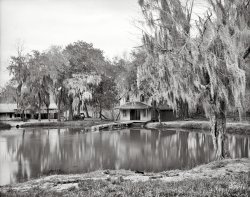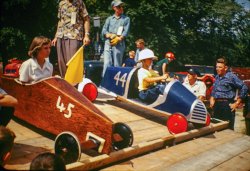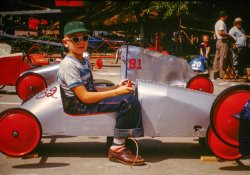
MAY CONTAIN NUTS

Search Shorpy
SHORPY ART

Framed or unframed, desk size to sofa size, printed by us in Arizona and Alabama since 2007. Explore now.
Join and Share
Ad-Free Shorpy
Shorpy is funded by you. Patreon contributors get an ad-free experience.
Learn more.

Recent comments
- Party of Eight?
- Good choice
- Recent view
- Hudson’s Big Store
- Say what??
- Grapes?!
- Just a Great photograph.
- A Beautiful Moment
- Such joy
- Bethune-Cookman University today
- Yellow sky at morning
- Side Winder
- Air Quality?
- Sojourner Truth riot
- None were so blind(ed)
- The less famous sister
- Good ol' days?
- Rise and Fall
- Goo Goo Ga Joob
- Ticket Retention
- Not the only one
- Vagaries of War
- Killed by Amtrak
- Back to the Future
- Wanted --
- If you can't stand the light
- Centralized Traffic Control, I believe
- What's really happening
- Heckuva remote control!
- Sometimes — Things Go Bump!
Member Photos
The Shorpy
Print Emporium
Print Emporium
Search Shorpy
Search results -- 30 results per page
- Ready to Rumble: 1928
- ... long as you keep the rumble seat closed.
(The Gallery, Cars, Trucks, Buses, Chris Helin, San Francisco) ... Posted by Dave - 10/12/2014 - 7:28pm -
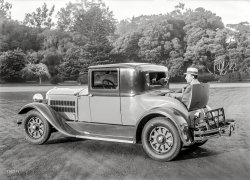
- In Transit: 1927
- ...
...including fine-made casket of quality,
hearse, cars and embalming, use of our funeral parlors.
$75, $100, $125, $150 up ... Posted by Dave - 09/13/2011 - 2:02pm -
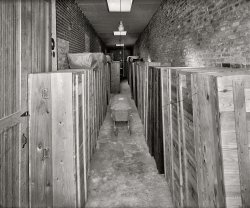
- The Illuminating Co.: 1900
- ...
On the left is pair of open-bench "toast rack" trolley cars, possibly one powered and the other a non-powered trailer. (Can't be ... Posted by Dave - 06/29/2015 - 10:33am -
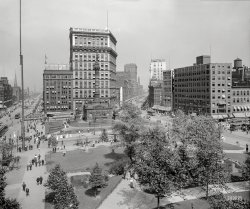
- M.I.T.: 1901
- ... Did they put them away and bring out more of the enclosed cars? That would sure require an extensive overall fleet investment. I've ... Posted by Dave - 07/30/2012 - 4:37pm -
![M.I.T.: 1901 Boston circa 1901. "Massachusetts Institute of Technology, Rogers Building." 8x10 inch dry plate glass negative, Detroit Publishing Company. View full size.
Check outCheck out the nearly-identical image.
[A Detroit Publishing Co. postcard]
Man in frontHe's just scratching his eye. Really.
1866 - 1939MIT's First Building, 95 feet wide by 140 feet long, consisting of five stories and one half story.
Biological Laboratory
In 1883, one year after the death of William Barton Rogers, the MIT Corporation voted to name the facility “The Rogers Building.” Already, however, the Institute had started to outgrow the building. By the early twentieth century MIT had spread to a dozen or so buildings in the Copley Square area and the need for more space was obvious, foreshadowing the Institute’s 1916 move of most operations to the current Cambridge campus. The old Rogers Building continued in use as the School of Architecture into the 1930s. In 1937 it was purchased by the New England Mutual Life Insurance Company and razed in 1939 to make way for their new home office.
M.I.T.'s first building. More on The Rogers Building.
Cambridge?That would be Cambridge, not Boston, no?
[Prior to 1916, M.I.T. was located in Boston.]
BreezersInteresting how many photos of cities in the temperate zone show those open-air streetcars or "breezers," as they're sometimes called. Wonder what they did in winter time. Did they put them away and bring out more of the enclosed cars? That would sure require an extensive overall fleet investment. I've enjoyed riding on breezers at an Iowa location, and they don't look like they could be fitted with any kind of enclosing protection.
(The Gallery, Boston, DPC, Horses, Streetcars)](https://www.shorpy.com/files/images/SHORPY_4a07478a.thumbnail.jpg)
- Coupe de Fille: 1928
- ... a bullet-proofed 1928 Cadilllac sedan.
(The Gallery, Cars, Trucks, Buses, Chris Helin, San Francisco) ... Posted by Dave - 04/18/2016 - 3:40pm -
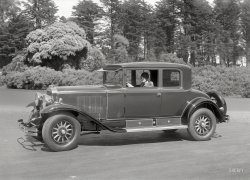
- Girls in Convertible
- ... Buick Convertible Coupe.
(ShorpyBlog, Member Gallery, Cars, Trucks, Buses) ... Posted by Sam O. - 09/22/2011 - 11:02pm -
![Girls in Convertible Another found snapshot. Can someone please identify the car? [It's a 1940 Buick. - Dave] View full size.
It's a BuickThis is a 1940 Buick Convertible Coupe.
(ShorpyBlog, Member Gallery, Cars, Trucks, Buses)](https://www.shorpy.com/files/images/40scar_0.thumbnail.jpg)
- Official Delegation: 1922
- ... nudge this into the Pretty Girls tag.
(The Gallery, Cars, Trucks, Buses, D.C., Harris + Ewing) ... Posted by Dave - 06/20/2014 - 3:08pm -
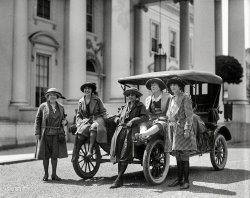
- War Risk: 1923
- ... missing are two headlights. - Dave]
(The Gallery, Cars, Trucks, Buses, D.C., Natl Photo, WWI) ... Posted by Dave - 04/04/2017 - 11:51am -
![War Risk: 1923 The Bureau of War Risk Insurance, a World War I agency that over the past century morphed into the Department of Veterans Affairs, which still occupies this building. Plus ça change ...
Washington, D.C., 1923. "War Risk Bureau, Vermont Avenue and I Street N.W." 8x10 inch glass negative, National Photo Company Collection. View full size.
Getting inside isn't easyLast month I attended a meeting at 801 Vermont Ave NW. The entrance is on the left under the mock columns and once inside the unwary visitor discovers an area about 8x10 feet devoted to security screening conducted by a team of crack contract employees. The space is too small for the number of visitors trying to enter and the crack contract employees are not very helpful. Not surprisingly, this entrance has a well known poor reputation. At 8 a.m. there is always a line of folks on the sidewalk.
Perspective!I love how the top looks larger than the bottom, and the corener looms over us due to the lens used. Makes it obvious why cartoons are showing oddly shaped buildings to imitate perspective!
And, is that "crack team" any more intelligent than the minimum wage idiots with TSA?
[I bet they know how to spell "coroner." - Dave]
DaytripperWhat's the story with the front automobile having black headlamp reflectors? Wouldn't that limit one to travel during daylight hours only? I'm sure I'm missing something here.
[What's missing are two headlights. - Dave]
(The Gallery, Cars, Trucks, Buses, D.C., Natl Photo, WWI)](https://www.shorpy.com/files/images/SHORPY-30468u.thumbnail.jpg)
- Chew Sing: 1915
- ... introduced for the conversion of Ford and other light cars into efficient and economical one-ton trucks will occupy a prominent ... customizing goes back over 100 years.
(The Gallery, Cars, Trucks, Buses, San Francisco) ... Posted by Dave - 04/18/2017 - 8:38am -
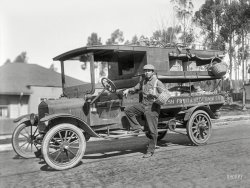
- Tee Party: 1919
- ... 50 years or so old then, survive today.
(The Gallery, Cars, Trucks, Buses, Chris Helin, San Francisco, Sports) ... Posted by Dave - 05/01/2017 - 2:01pm -
![Tee Party: 1919 1919. "Paige touring car at San Francisco Golf Club." Our second look at the "driving" range. 5x7 glass negative by Christopher Helin. View full size.
Are Those Shingles Wood or Slate ?Could those perhaps be slate shingles, rather than wood ?
I've seen slate roofs laid up like that. The ones I've seen were on late 19th or early 20th century buildings which were designed to look "Old World"
Thatch style shinglingA few examples of this type of roofing do in fact still exist in the San Francisco in the Westwood Highlands district of San Francisco. Many English Cottages were built in the 1920's to attract a burgeoning middle class with affordable houses built from scratch. These houses feature cottage roofs, stained glass and other signs of refined decoration. It is one of the most beautiful residential neighborhoods, however obscure the name is compared to better known neighborhoods. It is however in the deep fog prone area, bordered by St. Francis Woods, and during certain heavy fog seasons it is very reminiscent of movies like the Big Sleep.
Can anyone explainthe type of roofing on the building behind?
[Shingles imitating English-cottage thatch. - Dave]
Shingle ArtistryI have seen that pattern of wood roof shingle on cottages of the same era, in Hollywood California. Instead of being cut as rectangles, the wood shingles are cut with one ripple side. When the roofer lays them down, he creates the parallel waves in the way he overlaps the layers.
I have never seen anybody place the ripples as close together as they are on this roof. Maybe these are smaller tiles. The ones in Hollywood were two or three times the distance apart of these rows. But they had a wonderful aesthetic missing from commercial roofs laid today.
Alas, when these homes get re-roofed, nobody re-creates the original look. I saw them back in the 1970s. Doubt any of those roofs, which were 50 years or so old then, survive today.
(The Gallery, Cars, Trucks, Buses, Chris Helin, San Francisco, Sports)](https://www.shorpy.com/files/images/SHORPY-1155.thumbnail.jpg)
- Executone System
- ... poster first appeared.
(ShorpyBlog, Member Gallery, Cars, Trucks, Buses, Patriotic) ... Posted by The Inventor - 09/18/2011 - 11:20pm -
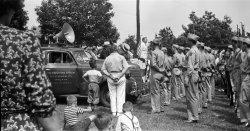
- Street View: 1920
- ... the same picture from September of 2015.
(The Gallery, Cars, Trucks, Buses, D.C., Natl Photo) ... Posted by Dave - 05/01/2014 - 9:23pm -
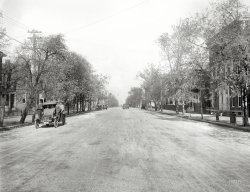
- The New World: 1936
- ... lit up and moved at night), all the pedestrians and 1930s cars! It just screams, New York!!
At Home Abroad A Little Song, A Little ... Posted by Dave - 01/10/2016 - 1:04pm -
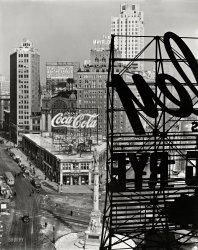
- Coach-Brougham: 1925
- ... the category of Things That Are No More.
(The Gallery, Cars, Trucks, Buses, Chris Helin, San Francisco) ... Posted by Dave - 09/27/2017 - 9:05pm -
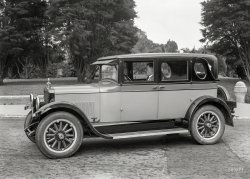
- Arecibo: 1942
- ... seeing 10 woodies in one picture. WOW!
(The Gallery, Cars, Trucks, Buses, Jack Delano, Puerto Rico) ... Posted by Dave - 03/05/2019 - 2:58pm -
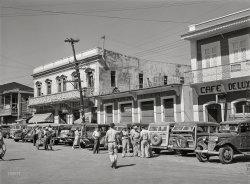
- South Bend Bound: 1956
- ... photo department.
(ShorpyBlog, Member Gallery, Cars, Trucks, Buses) ... Posted by JeffK - 10/02/2011 - 3:51pm -
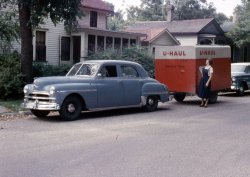
- Obelisk Flour: 1901
- ... scenes, you can add to horses and wagons and electric cars and horse apples and mysterious objects at the curb and intriguing ... Posted by Dave - 08/30/2020 - 4:59pm -
![Obelisk Flour: 1901 Washington, D.C., circa 1901. "View of E Street S.W., north side, looking east from Delaware Avenue, showing a grocery store on the corner." 5x7 inch glass negative. View full size.
PearlinePearline was a powdered soap (thanks, Google) Best By Test was their tagline and they really pushed it.
Mystery ObjectNear the curb, to the left of the image, is a once commonplace city streetside fixture, but now a highly collectable piece of ephemera--a horse spittoon!
Ah, but I jest.
This is actually a small flip-top fire hydrant. Here is an image featuring the same type at the Historical Society of Washington, D.C. website: D.C. hydrant
At aforementioned website, you can enter 'hydrant' under Keyword Search to discover additional images of the flip-top hydrant, including at least one image showing one 'flipped'.
High Grade foodSomehow that "High Grade Butter and Cheese" sign makes my mouth water. I'll bet the flavors were better than we get today.
Fels Naptha is still around!Who knew? And it helps with poison ivy.
What's that pot?Some Shorpyite will surely know what that cast-iron pot is on the curb to the left. Only thing I can think of is that it's a receptacle for folks picking up after their horses.
[It's a fire hydrant, as seen in the comments under this post from 2008. - Dave]
Obelisk Flour - ReliableIt will always rise to the occasion.
Little kid in the streetTo the list of interesting things Shorpy commenters love to note about street scenes, you can add to horses and wagons and electric cars and horse apples and mysterious objects at the curb and intriguing configurations of streetcar tracks: children wandering aimlessly in the road.
E is for ElmIn about 25 years all those elm trees lining E street will die from Dutch elm disease
Pettijohn's Breakfast Foodgave oatmeal a run for its money in those days, until Quaker Oats scooped it up in the mid-1920's. An 1897 ad assured the customer that it was made from only the finest Pacific Coast wheat, with all the nerve and strength-giving qualities carefully retained.
(The Gallery, D.C., D.C. Street Survey, Kids, Stores & Markets)](https://www.shorpy.com/files/images/SHORPY-40242a.thumbnail.jpg)
- Chrysler Airflow
- ... with today's gas mileage.
(ShorpyBlog, Member Gallery, Cars, Trucks, Buses) ... Posted by pammydale - 09/18/2011 - 10:18pm -
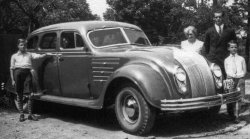
- Hot Sheets: 1938
- ... have that Ford door! Thats the reason we often find the cars and trucks with no doors. They took them off!
Jack In The Box Seems ... Posted by Dave - 10/24/2014 - 6:29am -
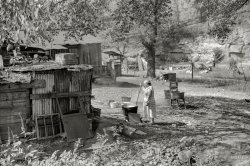
- Car Party
- ... driving his last one.
(ShorpyBlog, Member Gallery, Cars, Trucks, Buses) ... Posted by JustKickstart - 11/03/2010 - 9:12am -
![Car Party Since this is my wife's family, so I can't identify any of them, and I suck at identifying vehicles, hope you find something enjoyable anyway. View full size.
CorvetteThe sports car in the back is a Corvette. The sedan? Maybe a Buick.
[Pontiac. - Dave]
Fabricated RelationsThat's your wife's uncle Mario; her uncle Don's then-fiancee Barbara; Grandpa Lloyd; Don (who had five kids with Barbara); and Mario's wife Elaine (who drove the Corvette.)
Mario, a career Marine, drove big Pontiacs his entire life. Elaine recently stopped driving his last one.
(ShorpyBlog, Member Gallery, Cars, Trucks, Buses)](https://www.shorpy.com/files/images/carparty1.thumbnail.jpg)
- Tattoo II: 1941
- ... the way down at the far right, past the tops of the parked cars. Everything else is long gone.
Just a short walk from a long pier ... Posted by Dave - 06/24/2020 - 5:12pm -
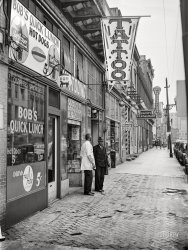
- Steeplechase Pier: 1905
- ... the Ferris Wheel and my best friend Felix ran the Dodgem cars. This was B.C. -- before casinos. A great place to grow up in.....Lew Bobb ... Posted by Dave - 08/13/2012 - 10:20pm -
![Steeplechase Pier: 1905 The Jersey Shore circa 1905. "Steeplechase Pier, Atlantic City." Appearing April 22: The Mask and Wig Club of U-Penn performing "Mr. Hamlet of Denmark." 8x10 inch dry plate glass negative, Detroit Publishing Company. View full size.
I wonder... what time of year this is? No one is on the beach or the pier.
[It's April. - Dave]
Shills rolling chairsWhy yes. I believe he is.
Gone, gone, all gone nowToday most of the traffic on the boardwalk is people shuffling from one gambling casino to the next. There are few attractions. The benches are mostly occupied by the homeless, who tend to be dirty and talk loudly to themselves. Instead of sun and the sounds of the surf, what most people experience these days is the constant din of endless rows of slot machines inside cavernous, windowless rooms. It's hard not to sound negative, AC really is bleak.
Got Windex ?Imagine the chore it must have been to keep those beautiful ornate windows clean. Salt spray had to be the worst culprit.
I was wondering.Quevic?
After this Steeplechase Pier Burnt DownI worked on the replacement Steeplechasr from 1944 to 1948, I ran the Ferris Wheel and my best friend Felix ran the Dodgem cars. This was B.C. -- before casinos. A great place to grow up in.....Lew Bobb
(The Gallery, Atlantic City, DPC, Swimming)](https://www.shorpy.com/files/images/4a12632a.thumbnail.jpg)
- The Muck Truck: 1942
- ...
(The Gallery, Agriculture, Cars, Trucks, Buses, John Collier) ... Posted by Dave - 06/10/2018 - 1:24pm -
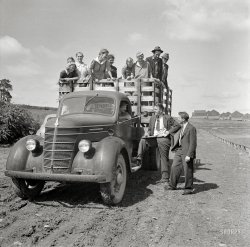
- New Beach: 1940
- ... picturesque dressing and undressing in and behind parked cars." 35mm nitrate negative by Edwin Rosskam for the Farm Security ... Posted by Dave - 01/14/2012 - 1:49pm -
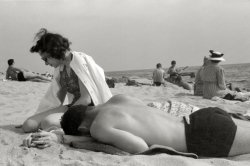
- 45 vs. 44: 1952
- ... Car 45 won, ending the tournament in a 4 way tie with Cars 13-16-81.
__________________
Massey Wins "Rocket Derby" as 78 ... times in 26.3 seconds and twice in 26.5. There were 52 cars which ran in the A division and 26 cars in the B division. Three cars ... Posted by Christoph Traugott - 10/29/2018 - 6:34am -
- Car 82: 1952
- ... Elmwood, Illinois, 1952. Car 82, tied with the 20 and 100 cars. The average times ranged from 25.8 seconds to 30 seconds. ... times in 26.3 seconds and twice in 26.5. There were 52 cars which ran in the A division and 26 cars in the B division. Three cars entered earlier in the A division did not ... Posted by Christoph Traugott - 10/29/2018 - 6:25am -
- Mar-Man: 1922
- ... be immortalized with his favorite ride?
(The Gallery, Cars, Trucks, Buses, Chris Helin, San Francisco) ... Posted by Dave - 04/27/2017 - 2:21pm -
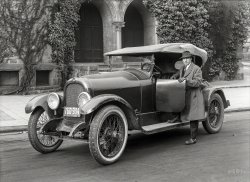
- Maxwell Crossing: 1924
- ... or saying a prayer regarding his brakes.
(The Gallery, Cars, Trucks, Buses, Chris Helin, San Francisco) ... Posted by Dave - 01/12/2017 - 1:54pm -
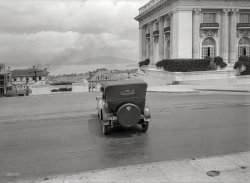
- High and Low: 1907
- ... pretty much the same.
(The Gallery, Bicycles, Cars, Trucks, Buses, Detroit Photos, DPC) ... Posted by Dave - 10/12/2018 - 9:08pm -
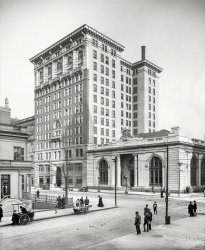
- DeLovely: 1904
- ... long "Visit DeLeon Springs" signs to the bumpers of the cars. My dad made sure the workers knew not to put a sign on our car.
At the ... Posted by Dave - 01/04/2013 - 8:55pm -
